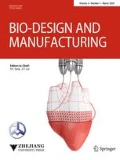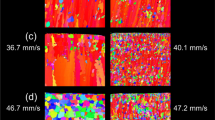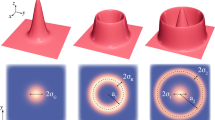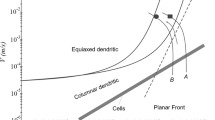Abstract
This work investigates the machining temperatures of ultra-fine-grained titanium (UFG Ti), prepared by equal channel angular extrusion, through analytical modeling. UFG Ti has great usefulness in biomedical applications because of its high mechanical strength, sufficient manufacturability, and high biocompatibility. The temperatures were predicted using a physics-based predictive model based on material constitutive relation and mechanics of the orthogonal cutting process. The minimization between the stress calculated using Johnson–Cook constitutive model and the same stress calculated using mechanics model yields the estimation of machining temperatures at two deformation zones. Good agreements are observed upon validation to the values reported in the literature. The machinability of UFG Ti is investigated by comparing its machining temperature to that of Ti–6Al–4V alloy under the same cutting conditions. Significantly lower temperatures are observed in machining UFG Ti. The computational efficiency of the presented model is investigated by comparing its average computational time (~ 0.5 s) to that of a widely used modified chip formation model (8900 s) with comparable prediction accuracy. This work extends the applicability of the presented temperature model to a broader class of materials, specifically ultra-fine-grained metals. The high computational efficiency allows the in situ temperature prediction and optimization of temperature condition with process parameters planning.





Similar content being viewed by others
References
Elias CN, Meyers MA, Valiev RZ, Monteiro SN (2013) Ultra fine grained titanium for biomedical applications: an overview of performance. J Mater Res Technol 2(4):340–350. https://doi.org/10.1016/j.jmrt.2013.07.003
Ning J, Nguyen V, Liang SY (2018) Analytical modeling of machining forces of ultra-fine-grained titanium. The Int J Adv Manuf Technol 101(1–4):627–636. https://doi.org/10.1007/s00170-018-2889-6
Anselme K, Noe B, Hardouin P (1999) Human osteoblast adhesion on titanium alloy, stainless steel, glass and plastic substrates with same surface topography. J Mater Sci Mater Med 10(12):815–819. https://doi.org/10.1023/A:1008992109670
Stolyarov VV, Zhu YT, Alexandrov IV, Lowe TC, Valiev RZ (2001) Influence of ECAP routes on the microstructure and properties of pure Ti. Mater Sci Eng A 299(1–2):59–67. https://doi.org/10.1016/S0921-5093(00)01411-8
Stolyarov VV, Zhu YT, Lowe TC, Valiev RZ (2001) Microstructure and properties of pure Ti processed by ECAP and cold extrusion. Mater Sci Eng A 303(1–2):82–89. https://doi.org/10.1016/S0921-5093(00)01884-0
Stolyarov VV, Zhu YT, Alexandrov IV, Lowe TC, Valiev RZ (2003) Grain refinement and properties of pure Ti processed by warm ECAP and cold rolling. Mater Sci Eng A 343(1–2):43–50. https://doi.org/10.1016/S0921-5093(02)00366-0
Horita Z, Fujinami T, Langdon TG (2001) The potential for scaling ECAP: effect of sample size on grain refinement and mechanical properties. Mater Sci Eng A 318:34–41. https://doi.org/10.1016/S0921-5093(01)01339-9
Longbottom JM, Lanham JD (2005) Cutting temperature measurement while machining—a review. Aircr Eng Aerosp Technol 77(2):122–130. https://doi.org/10.1108/00022660510585956
Komanduri R, Hou ZB (2001) A review of the experimental techniques for the measurement of heat and temperatures generated in some manufacturing processes and tribology. Tribol Int 34(10):653–682. https://doi.org/10.1016/S0301-679X(01)00068-8
Umbrello D, M’saoubi R, Outeiro JC (2007) The influence of Johnson–Cook material constants on finite element simulation of machining of AISI 316L steel. Int J Mach Tools Manuf 47(3–4):462–470. https://doi.org/10.1016/j.ijmachtools.2006.06.006
Özel T, Ulutan D (2012) Prediction of machining induced residual stresses in turning of titanium and nickel based alloys with experiments and finite element simulations. CIRP Ann-Manuf Technol 61(1):547–550. https://doi.org/10.1016/j.cirp.2012.03.100
Gonzalo O, Jauregi H, Uriarte LG, de Lacalle LL (2009) Prediction of specific force coefficients from a FEM cutting model. Int J Adv Manuf Technol 43(3–4):348. https://doi.org/10.1007/s00170-008-1717-9
Danish M, Ginta TL, Habib K, Carou D, Rani AMA, Saha BB (2017) Thermal analysis during turning of AZ31 magnesium alloy under dry and cryogenic conditions. Int J Adv Manuf Technol 91(5–8):2855–2868. https://doi.org/10.1007/s00170-016-9893-5
Guo YB, Yen DW (2004) A FEM study on mechanisms of discontinuous chip formation in hard machining. J Mater Process Technol 155:1350–1356. https://doi.org/10.1016/j.jmatprotec.2004.04.210
Feng Y, Lu YT, Lin YF et al (2018) Inverse analysis of the cutting force in laser-assisted milling on Inconel 718. Int J Adv Manuf Technol 96(1–4):905–914. https://doi.org/10.1007/s00170-018-1670-1
Ning J, Liang SY (2019) Predictive modeling of machining temperatures with force-temperature correlation using cutting mechanics and constitutive relation. Mater 12(2):284. https://doi.org/10.3390/ma12020284
Ning J, Liang S (2018) Prediction of temperature distribution in orthogonal machining based on the mechanics of the cutting process using a constitutive model. J Manuf Mater Process 2(2):37. https://doi.org/10.3390/jmmp2020037
Ning J, Liang S (2018) Evaluation of an analytical model in the prediction of machining temperature of AISI 1045 steel and AISI 4340 steel. J Manuf Mater Process 2(4):74. https://doi.org/10.3390/jmmp2040074
Ning J, Liang SY (2019) A comparative study of analytical thermal models to predict the orthogonal cutting temperature of AISI 1045 steel. Int J Adv Manuf Technol 102(9–12):3109–3119. https://doi.org/10.1007/s00170-019-03415-9
Shalaby MA, El Hakim MA, Veldhuis SC (2018) A thermal model for hard precision turning. Int J Adv Manuf Technol 98:2401–2413. https://doi.org/10.1007/s00170-018-2389-8
Lalwani DI, Mehta NK, Jain PK (2009) Extension of Oxley’s predictive machining theory for Johnson and Cook flow stress model. J Mater Process Technol 209(12–13):5305–5312. https://doi.org/10.1016/j.jmatprotec.2009.03.020
Oxley PLB (1989) The Mechanics of machining: an analytical approach to assessing machinability. Ellis Horwood, London
Komanduri R, Hou ZB (2001) Thermal modeling of the metal cutting process—part III: temperature rise distribution due to the combined effects of shear plane heat source and the tool–chip interface frictional heat source. Int J Mech Sci 43(1):89–107. https://doi.org/10.1016/S0020-7403(99)00105-8
Ning J, Nguyen V, Huang Y, Hartwig KT, Liang SY (2018) Inverse determination of Johnson–Cook model constants of ultra-fine-grained titanium based on chip formation model and iterative gradient search. Int J Adv Manuf Technol 99(5–8):1131–1140. https://doi.org/10.1007/s00170-018-2508-6
Ivester RW, Kennedy M, Davies M, Stevenson R, Thiele J, Furness R, Athavale S (2000) Assessment of machining models: progress report. Mach Sci Technol 4(3):511–538. https://doi.org/10.1080/10940340008945720
Kolsky H (1949) An investigation of the mechanical properties of materials at very high rates of loading. Proc Phys Soc Sect B 62(11):676
Shrot A, Bäker M (2012) Determination of Johnson–Cook parameters from machining simulations. Comput Mater Sci 52(1):298–304. https://doi.org/10.1016/j.commatsci.2011.07.035
Agmell M, Ahadi A, Ståhl JE (2014) Identification of plasticity constants from orthogonal cutting and inverse analysis. Mech Mater 77:43–51. https://doi.org/10.1016/j.mechmat.2014.07.005
Ning J, Liang SY (2018) Model-driven determination of Johnson–Cook material constants using temperature and force measurements. Int J Adv Manuf Technol 97(1–4):1053–1060. https://doi.org/10.1007/s00170-018-2022-x
Ning J, Liang SY (2019) Inverse identification of Johnson–Cook material constants based on modified chip formation model and iterative gradient search using temperature and force measurements. Int J Adv Manuf Technol 102(9–12):2865–2876. https://doi.org/10.1007/s00170-019-03286-0
Seo S, Min O, Yang H (2005) Constitutive equation for Ti–6Al–4V at high temperatures measured using the SHPB technique. Int J Impact Eng 31(6):735–754. https://doi.org/10.1016/j.ijimpeng.2004.04.010
Boivineau M, Cagran C, Doytier D, Eyraud V, Nadal MH, Wilthan B, Pottlacher G (2006) Thermophysical properties of solid and liquid Ti–6Al–4V (TA6 V) alloy. Int J Thermophys 27(2):507–529. https://doi.org/10.1007/PL00021868
Pan Z, Lu YT, Lin YF, Hung TP, Hsu FC, Liang SY (2017) Analytical model for force prediction in laser-assisted milling of IN718. Int J Adv Manuf Technol 90(9–12):2935–2942. https://doi.org/10.1007/s00170-016-9629-6
Author information
Authors and Affiliations
Corresponding author
Ethics declarations
Conflict of interest
The authors declare that they have no conflict of interest.
Human and animal rights
This article does not contain any studies with human or animal subject performed by any of the authors.
Rights and permissions
About this article
Cite this article
Ning, J., Nguyen, V., Huang, Y. et al. Constitutive modeling of ultra-fine-grained titanium flow stress for machining temperature prediction. Bio-des. Manuf. 2, 153–160 (2019). https://doi.org/10.1007/s42242-019-00044-9
Received:
Accepted:
Published:
Issue Date:
DOI: https://doi.org/10.1007/s42242-019-00044-9




